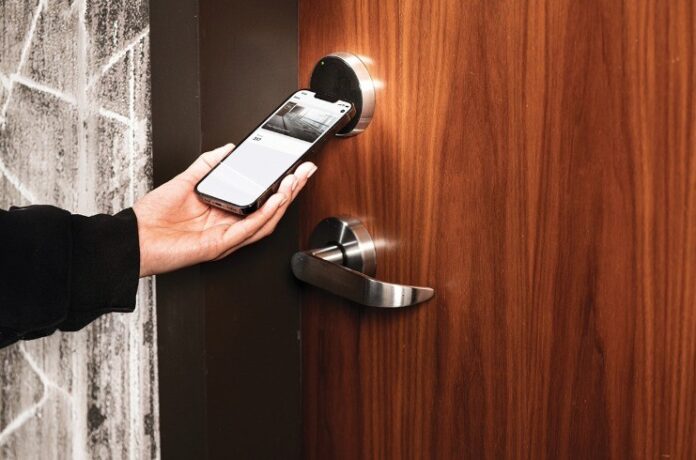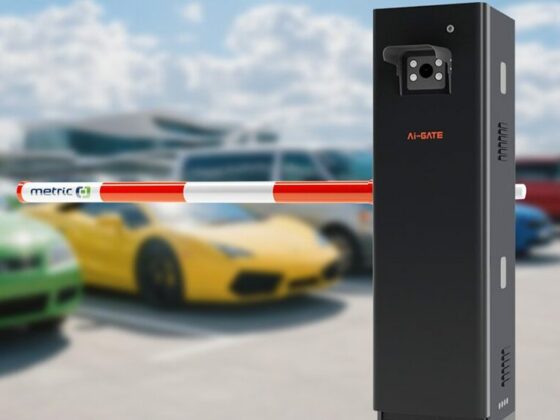
Wireless technology has become so pervasive in the hotel industry that it is even enhancing commonplace mechanisms such as the door lock. Among all the locks to be found throughout a hotel, guest-facing locks are being equipped with the most robust tech stacks, adding security functionality while meeting the expectation for flexibility and convenience in the guest journey. “As we see more residential experiences adapt to a digital form, that automatically transitions to the guest experience in a hotel, because people become used to that type of experience,” observed Darien Long, senior vice president, specialty access control solutions for dormakaba North America.
George Winker, VP of sales, North America, Vingcard, elaborated on the point: “Many [guests] have grown accustomed to the seamless ease that mobile-enabled services provide in other parts of their lives and are seeking out the same advantages when checking in and accessing hotel rooms. A growing number significantly want to remove as many obstacles standing in the way of guestroom entry as possible, which is why digital wallet-enabled mobile keys are rapidly growing in popularity, as they avoid the need to download and learn how to navigate a new mobile app.”
Evincing the rising popularity of digital wallet-enabled mobile keys is dormakaba’s installation of room keys in Apple Wallet at Resorts World Las Vegas in June. The technology lets guests seamlessly access their room and hotel facilities by holding their iPhone or Apple Watch near the door’s NFC (near-field communication) reader. “We’re seeing hotels definitely move to that NFC experience versus the BLE [Bluetooth Low Energy]. BLE has been around for a while, and it’s not exactly the best frictionless experience because in most cases, guests do have to navigate toward an app,” Long explained. With NFC, hoteliers “can do what we call web provisioning, which is the ability to issue mobile keys outside of an app and outside of a guest loyalty program too.”
Shifting to NFC evidently drove guest satisfaction at Resorts World, according to an initial case study by dormakaba. “Prior to moving to NFC, [Resorts World] did have a mobile key program on BLE, and they were only getting about 15 percent conversion of guests using mobile key. And now that they’ve moved to NFC, they’ve seen that jump to 44 percent of guests who are now leveraging that type of experience,” Long reported. Adding to the convenience, the technology’s Express Mode allows guests to tap and enter without waking or unlocking their device to use their room key. And if their iPhone needs to be charged, they can use their device to unlock their room or common areas for up to five hours with automatic Power Reserve.
While these mobile room key solutions are highly convenient, “hoteliers need to keep in mind that a substantial number of guests still value the familiarity of physical keys,” advised Winker. “The goal should therefore be to provide guests themselves with the ability to choose depending on what might best suit their diverse needs. For some, the preference might be for mobile keys or traditional keycards, while others may prefer a wristband or key fob, especially if they are staying at a resort or theme park hotel.”
“A Computer on a Door”
Locks equipped with wireless technology not only remove friction from the guest journey; they can also enable hotel operators to gather data on the properties and usage trends for particular doors. A lock with online connectivity to an access management system can provide an alert if its door has been left open, data on who has accessed that room and how often, and other information that can flag potential security threats. “It’s essentially a computer on a door,” said Long. “Right now, we’re participating in a project to help us understand what alerts could be helpful in identifying patterns of human trafficking. So, I think there’s a lot that we can do” with access management technology. She added that an online lock is “definitely a more expensive purchase … but hotels are finding ROI in this purchase. [For example] “they’re integrating it with their guestroom energy management solutions.” The integrated system could, for instance, control air conditioner settings based on who is entering or leaving the room, whether a guest or housekeeper.
Integration with energy management systems exemplifies “the next generation of electronic locks,” which “will be defined by even more integration and intelligence,” said Winker. “Enhanced connectivity is increasingly being leveraged that is allowing locks to serve as part of a larger ecosystem by interacting with guest mobile apps and in-room controls such as thermostats, TVs, drapes, and lights. Ultimately, locks will be less focused on isolated hardware and more about contributing to a holistic and personalized guest-centric experience.”
Future-Readiness
More than ever before, locks need to be adaptable to new developments in access technology, and hoteliers are taking that into account when buying these products. While a lock is typically good for 10 years on average from a hardware perspective, technology will evolve during those years, and hoteliers want to be able to take advantage of the upgrades without replacing all their locks.
Accordingly, “we see hotels [adopting] more modular updates of the electronics versus the actual full lock replacement, because we’re seeing advancements in some of that tech stack [occur] more frequently than the lifecycle,” said Long. As Winker put it, “The use of modular components provides hoteliers with greater flexibility over what functionalities they wish to adopt. This can even include implementing battery-free capabilities where door locks wirelessly receive power through the doorframe, saving staff time, lowering costs, and reducing waste.”
Aligning With Design
While the smart lock’s main roles are facilitating the guest journey and enhancing security, it is also a component of the hotel’s look and feel, and its design should align with the overall design of the property. “Lock design has become an extension of the guestroom’s interior design rather than an afterthought,” said Winker. “Hotels are moving away from bulky hardware toward slimmer, more discreet profiles that blend with a building’s unique aesthetics.” He added, “Custom finishes and minimalist form factors are increasingly requested to align with branding and design themes. The trend reflects the idea that security technology should be present but not intrusive, allowing guests to feel both safe and immersed in the property’s design vision.” Accordingly, lock electronics that are hidden in the wall cavity tend to be preferred from an aesthetic point of view.
Major suppliers of hospitality door locks like dormakaba and Vingcard offer multiple styles and finishes that align with various types of properties. “You’ll see different hotels pick different finishes and lever styles based on how they would segment themselves,” Long noted. “So, you might see modern hotels go with something like a matte black finish and a very sleek lever, whereas a historic hotel may go with antique bronze and a heavier lever set. … All of our locks are configurable to meet not only their tech stack, but also the aesthetics that they’re looking for on the door.”
3 Reader Technologies: Differentiating RFID, NFC, and BLE in the Smart Lock Industry
While RFID (radio frequency identification) technology is considered the standard wireless technology for electronic door lock readers, BLE (Bluetooth Low Energy) and NFC (near-field communication) are becoming more prevalent as hoteliers seek to offer more mobile key deployment options such as digital wallet-based room keys. George Winker, VP of sales, North America, Vingcard, overviews the distinguishing features of these technologies:
• RFID is a broad technology that uses radio waves to identify and track cards or tags. In the hotel context, RFID keycards typically offer longer range, one-way communication, where the card transmits a token to the reader. As it is durable and cost-effective, it is widely used but its unidirectional nature makes it less practical for newer features and functionalities such as mobile keys.
• NFC serves as a subset of RFID that operates at a high frequency and a much shorter range. This ultimately requires closer contact with the reader. Unlike traditional RFID, NFC supports secure, two-way communication, enabling features like mobile access and contactless payments. Its ability to interact with smartphones and consumer devices makes it ideal for today’s hospitality environments, where guests expect secure, flexible, and mobile-first options.
• BLE takes a different approach altogether by enabling secure communication between a mobile device and a lock over a longer range without requiring contact. BLE underpins many mobile key solutions, allowing guests to unlock doors simply by approaching them with their smartphone or wearable device.







